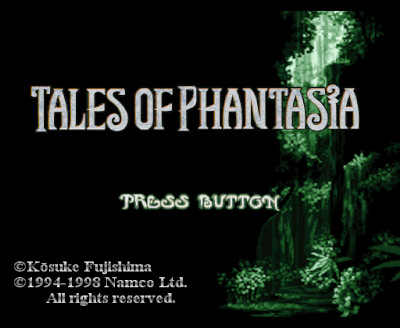
Tales of Phantasia (PlayStation) Review
~by tankMage (May 2024)
Score: 9/10 (Excellent)
This is what a remake should look like.
There’s a famous meme that features Kermit the Frog wistfully looking through a window on a rainy day. The image is captioned something like “When you finish a great game.” and it’s what came to mind when I completed Tales of Phantasia. As you likely know, Phantasia is one of those exclusively Japanese Super Nintendo/Famicom games that gets a lot of fanfare. It also appeared as a remake on PS1, but the west did not see official releases of it until the days of the PSP and Game Boy Advance. Each version of Phantasia varies from the other, so this review focuses on the PlayStation remake and its translation by Absolute Zero.
It’s no surprise this title was so highly praised, as it manages to seamlessly blend fast paced combat and traditional RPG gameplay. It also has a great cast of characters and a story that was able to capture my attention throughout the course of the adventure. While I really love the core gameplay and plot, it was the beautiful graphics that really captivated me. I’m not one to drool over visuals (usually I barely care about how a game looks) but Phantasia was alive with detail, so much so that it could very well be the best example of a beautiful PS1 game. At the end of the day, Phantasia is not only a great game, but it is also an example of what a remake should strive to accomplish.
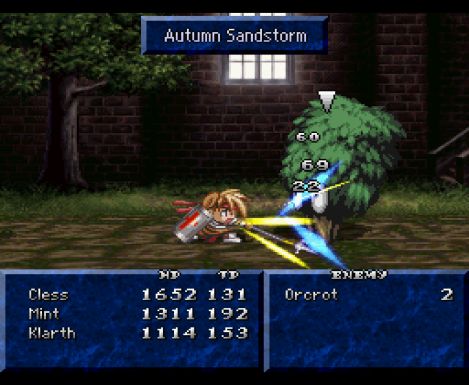
What’s the gameplay like?
Like just about any other JRPG, Phantasia has players searching dungeons, fighting random battles, exploring towns, casting spells, and doing anything else you can think of. What makes it special from a gameplay standpoint is its battle engine. Fights take place in real time with the player in control of the main character, a swordsman named Cless. You can move around the screen, use regular thrusts and slashes, or pull off special attacks with Cless. Players can also issue commands to the other three party members or let the game’s AI control them.
If the ability to fully control Cless is not good enough for you, equipping the other party members with Channeling Rings allows up to three more players to join in the fun. There are also items that give the player greater control over Cless to the point that they can enter his special moves using fighting game style combos.
If there’s anything bad about the battle engine, I’d say that maybe it can be a bit too intense at times. Boss fights are exciting and climactic, but having to button mash in every random battle gets a little tiresome after 30 hours or so. It is possible to set Cless to be controlled by the computer and just coast through unimportant fights, but the computer is not effective in combat.
Players can expect to explore plenty of dungeons over the course of the adventure. Each dungeon has its own gimmick and is usually home to monsters as well as puzzles. The devs tried to make every dungeon more or less unique, but met with mixed results. For example, one dungeon was an icy maze that required players to wear special accessories to survive. It was a good dungeon with a few clever puzzles. On the other hand, another dungeon was an attempt to simulate a large scale battle. This one was disappointing, because it was just a tangle of paths filled with enemies that would jump the party. While the dungeon design in Phantasia had it’s ups and downs, the successes outweighed the failures. The majority of the dungeons were well designed and creative enough to keep the game entertaining from start to finish.
The game world is dotted with towns to explore, each of which is full of its own surprises. To avoid spoilers, I will only say that players get to see various versions of each town. Despite the creativity that was put into the towns, the tend to be very small. This is likely a result of Phantasia being on the Super Famicom. The devs pushed the SFC to its limits, but this left little room on the cart for things like towns.
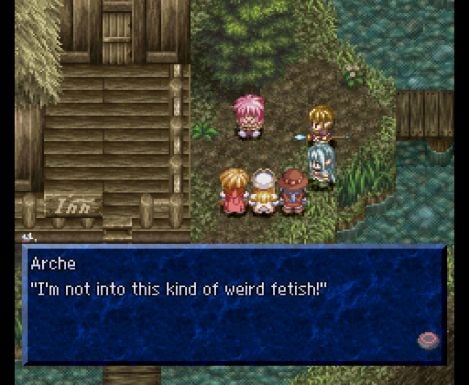
I touched on the party a bit earlier. Their are six playable characters in all. Two of the characters are basically offensive spell casters, one is a healer, and the other three are more or less physical damage dealers. Each character is fairly unique with his or her own skills. Chester can shoot a variety of special arrows, Suzu (a semi-secret ninja) uses ninpo to defeat enemies, and Arche can blast baddies with powerful spells to name a few. I liked the selection of heroes, but the party feels kind of small. The upshot of this is the devs were able to really flesh everyone out and none of the heroes come off as extraneous.
It’s a beautiful world.
Like I said, the graphics are truly beautiful. For starters there’s a few nice looking anime cutscenes, which aren’t top notch, but they are certainly up to PS1 standards. That said, it’s the normal game world that truly stands out. Reflective surfaces, animated wild life, and cleverly used transparencies bring the game to life. There are even shadow effects that look like they belong on the PS2, which surprised me. As much as I liked all the details, it was ultimately the general art style that impressed me the most. Everything was well designed and mistakes that were apparently in the original (like sprites not matching character portraits) were corrected. To top it all off, the spell and ability effects also look awesome.
I have a few nitpicks concerning the graphics. For one thing, there’s an awful lot of enemy sprite recycling. Once again, this is likely a left over from the game’s 16-Bit roots, but they could have drawn a few new sprites for monsters. There were also a few dungeons that looked like they were low effort in terms of graphics. Ironically, this was the result of the game setting such a high bar for itself, because these “low effort” dungeons were generally of the same quality one would expect from just about any other PlayStation RPG.
Good guys you’ll love and a villain you’ll love to hate.
Phantasia’s story isn’t exactly a masterpiece, but it does a good job of entertaining the player with a lovable cast, cool setting, and a badass villain. The game world features magic, references to Norse mythology, time travel, and a ton of video game cliches that are re-explored in an often unexpected ways.
Cless and his friends are the true strength of the story. They were written to be likable and treated with a sense of humor as well as sentimentality that is not often encountered. To improve the story and character development even more, the developers added skits that can be played on the overworld map to the remake. While some of the skits were serious or simply gave the player hints at where to go next, others were very funny. Sure, some of the jokes were corny JRPG gags, but others had me chuckling out loud.
Dhaos, the main villain, was also a great aspect of the story as he was both evil and mysterious enough to push the plot forward. One of the things I liked about Dhaos was that he actively tried to avoid or defeat the party throughout the story, which has the protagonists chasing him through time. Even better, there’s more to Dhaos than meets the eye, and while he is certainly a bad guy, he’s more than a one-dimensional caricature.
One thing I gotta say is I hate time travel as a plot device outside of a few movies and games that used it really well. For the most part it serves as a lazy way to retcon or turns a story into a convoluted mess. Phantasia did a good job of using time travel to showcase the game world and add depth to the story. Whoever did the writing was wise enough to place limitations on time travel and include characters that were smart enough to understand the dangers presented by such a power. The end result is a story that uses a plot device I find annoying in an original and effective manner.
That said, some aspects of the story were stretched thin a bit. This was both the result of time travel being a plot device and the actions of the villain leaving openings for the usual “Why didn’t they just do X, Y, or Z?” type questions. Ultimately these quirks are not severe and didn’t keep me from enjoying the story, it’s just best not to over think this one.
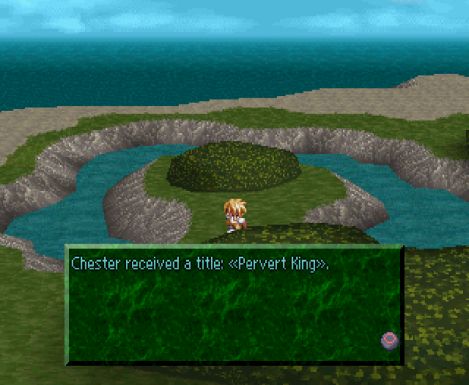
Backtracking, backtracking never changes.
Tales of Phantasia involves a good deal of backtracking. You’ll have to revisit old areas several times and most dungeons require players to retrace their steps to leave after completing the objective. A little backtracking is fine by me, but Tales tends to push the envelope a bit too hard in this regard. A warp spell would have helped a bit. It’s also clear that the devs were aware of the backtracky nature of the game, because there’s a few points where they give the player the option of taking a shortcut to whatever place they need to revisit. It is also worth keeping in mind that a good deal of the backtracking is optional and results in some nice rewards for patient players, so it’s not all bad.
Great music and voice acting.
Phantasia features a J-pop song in its intro video and one at the end credits. This was impressive back in the late 90s and really impressive when it was first released on the Super Famicom. The rest of the soundtrack is instrumental and just about perfect. I will say the musical style of the composers does not quite align with my own tastes, but I know good music when I hear it. I’ll also add that I love the boss theme.
It’s worth noting that all of the tracks are remixes of the original game’s BGM. Remixes can go really well or really badly. Luckily, Phantasia’s soundtrack falls into the former category. This can likely be attributed to the involvement of the original composers, who even make cameos in the game.
There’s also a lot of voice acting for a PS1 game and I’m kind of surprised they were able to fit it all on one disc. Of course the VOs are all in Japanese, so it’s kind of hard to say exactly how good the acting is, but it’s clearly far better than what we got for most games in the west.
A surprisingly “modern” user interface.
User interfaces for video games were starting to evolve at this point, but their quality varied greatly. Phantasia’s UI is top notch. The real time battle controls are responsive and easy to memorize, which makes fighting battles all the more fun. The inventory system, which is often the bane of older games, is very easy to navigate and gives players the ability to arrange items anyway they like. Of course, the UI could have been a little cleaner, because the main menu is cluttered with options, but it’s also convenient.
Odds, ends, and various sundries.
There’s a lot of stuff in Tales of Phantasia that I left out of this review to keep it from being a mile long. A lot of these things are small, but cool details like being able to cook or transform items using Rune Bottles. Other features include challenging secret bosses and a few bonus dungeons. All of these extras add up to make Phantasia even better.
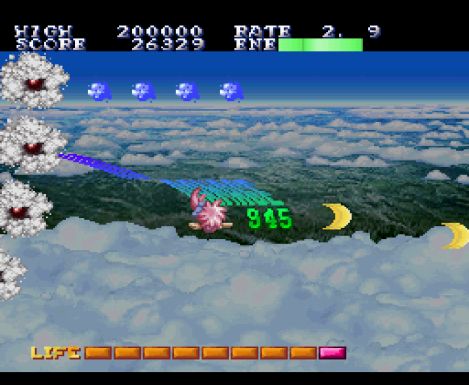
Absolute Zero’s Translation
This game was originally exclusive to Japan. In fact, I am fairly certain the west did not get Phantasia until the PSP/GBA era. Fortunately, fan translators swooped in to save the day and there’s several English patches for this game. I went with Absolute Zero’s translation, because it is considered the most faithful. That doesn’t mean I necessarily think a more liberal translation of this or any other game is bad, it’s just a matter of personal preference.
At any rate, Absolute Zero did an excellent job on the script from what I can tell. There were only a few typographical errors here and there (about the same amount you’d see in an official translation) and the scant few words of Japanese I could recognize in the VOs lined up with the text. They even gave players the option of choosing between Romanized names and direct translations of abilities, which was pretty cool. All in all, Absolute Zero did a commendable job, so much so that I have to say this may be the best fan translation I’ve played to date.
You should probably play Tales of Phantasia if you like RPGs.
If it wasn’t obvious from the rest of this review, I really enjoyed Phantasia and I think it is well worth playing. The only caveat is it may be difficult to choose which version of this game you want to play. Having only played the PS1 version fully and a bit of the SFC original, I have to say the PS1 remake is a huge upgrade. On the same token, I think it is always worthwhile to play the original version of a game just to see what it was like in its true form. To further complicate matters, there’s also PSP and GBA releases that I do not know much about. In the end, I can only fully recommend this one, since it’s the one I played, but Phantasia is likely a great game no matter what incarnation of it you choose.
Thanks for reading my Tales of Phantasia review!
RetroMaggedon.com ©2024
